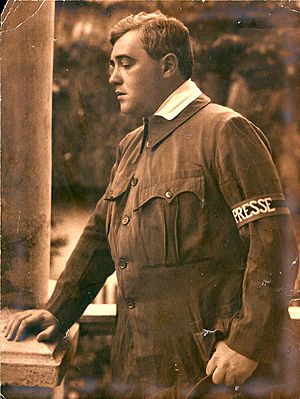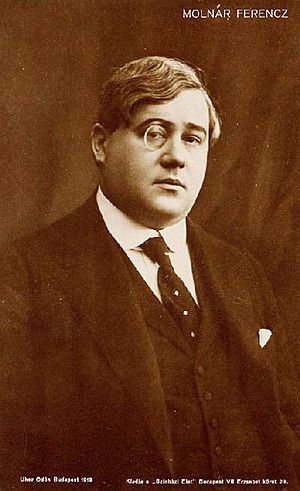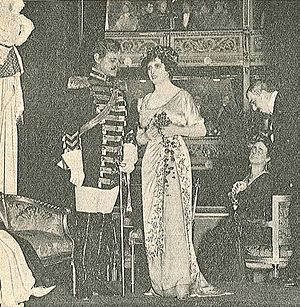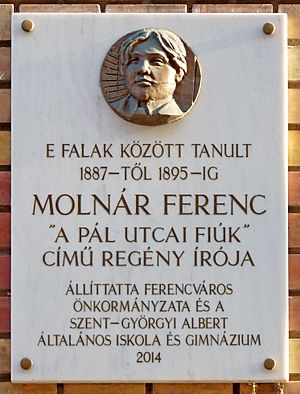Ferenc Molnár facts for kids
Quick facts for kids
Ferenc Molnár
|
|
|---|---|

Portrait by Carl Van Vechten, 1941
|
|
| Born | Ferenc Neumann 12 January 1878 Budapest, Austria-Hungary (today Hungary) |
| Died | 1 April 1952 (aged 74) New York City, New York, |
| Resting place | Linden Hill Cemetery, Ridgewood, Queens |
| Occupation | Novelist |
| Years active | 1901–1952 |
| Spouse | Margit Vészi (1906–1910; divorced; 1 child) Sári Fedák (1922–1925; divorced) Lili Darvas (1926–1952; his death) |
| Children | Marta Molnar Sarkozi (1907–1966) |
Ferenc Molnár ( ferr-ENTS-_-MOHL-nar-,_--ənts born Ferenc Neumann; 12 January 1878 – 1 April 1952), often anglicized as Franz Molnar, was a Hungarian-born author, stage-director, dramatist, and poet, widely regarded as Hungary’s most celebrated and controversial playwright. His primary aim through his writing was to entertain by transforming his personal experiences into literary works of art. He was never connected to any one literary movement but he did utilize the precepts of naturalism, Neo-Romanticism, Expressionism, and the Freudian psychoanalytical concepts, but only as long as they suited his desires. “By fusing the realistic narrative and stage tradition of Hungary with Western influences into a cosmopolitan amalgam, Molnár emerged as a versatile artist whose style was uniquely his own.”
As a novelist, Molnár may best be remembered for The Paul Street Boys, the story of two rival gangs of youths in Budapest. It has been translated into fourteen languages and adapted for the stage and film. It has been considered a masterpiece by many. It was, however, as a playwright that he made his greatest contribution and how he is best known internationally. "In his graceful, whimsical, sophisticated drawing-room comedies, he provided a felicitous synthesis of naturalism]] and fantasy, realism and romanticism, cynicism and sentimentality, the profane and the sublime." Out of his many plays, The Devil, Liliom, The Swan, The Guardsman and The Play's the Thing endure as classics. He was influenced by the likes of Oscar Wilde, George Bernard Shaw, and Gerhart Hauptmann. He immigrated to the United States to escape persecution of Hungarian Jews during World War II and later adopted American citizenship. Molnár’s plays continue to be relevant and are performed all over the world. His national and international fame has inspired many Hungarian playwrights including Elemér Boross, László Fodor, Lajos Bíró, László Bús-Fekete, Ernő Vajda, Attila Orbók, and Imre Földes, among others.
Contents
Life
Early years
Ferenc Molnár was born in Budapest on January 12, 1878 to Dr. Mór Neumann, a prosperous and popular gastroenterologist, and Jozefa Wallfisch. The home in which he lived was opulent but gloomy. Even though he was born into wealth, "It was not a friendly atmosphere for the lively and precocious Ferenc, who constantly had to be warned to keep quiet." Just a year before his birth, his parent's first born son and Molnár's brother, László, died. His mother was frail and frequently bedridden. Illness spread throughout the rooms of his house, and young Ferenc constantly was being told to keep quiet.
In 1887, Molnár entered the Református Gimnázium, a secondary school (high school) located in Miskolc, Hungary, where he was inspired to learn foreign languages and where his talent as a writer began to take shape. At the age of 14, he started a periodical titled Haladás (Progress) which sold only four copies and a secondary publication titled É letképek (Panorama) selling only 20 copies. His first dramatic work was Kék barlang (Blue Cave), a controversial play written, directed, and staged in the basement of a friend's house.
Upon completing secondary school, Molnár studied law at the University of Budapest in 1895, and shortly thereafter, he was sent to Geneva by his father to continue his studies at the Swiss University. While living in Geneva, he began writing frequently, often sending his work to various papers. Molnár also wrote the short novella Magdolna during this time. He also traveled to Paris to see some of the popular new plays. "The fashionable boulevard comedies of Bernstein, Bataille, Capus, and others left a deep impression on him and later greatly influenced his dramatic style."
In 1896, he abandoned a legal career to pursue a full-time career as a journalist. He covered a variety of topics during his time as a journalist, but his primary focus was the court trials for Vészi's Budapesti Napló (Budapest Daily), a newspaper then edited and published by József Vészi, a Jewish intellectual who dominated Hungarian political journalism. Molnár's first wife was one of Vészi's daughters (Margit Vészi). His mother died in 1898 when Ferenc was 20 years of age. Molnár served as a proud and jingoistic supporter of the Austro-Hungarian Empire while working as a war correspondent during World War I. So positive were his war reports that he was decorated by the Habsburg emperor, but criticized by some of his pacifist peers. He later wrote Reflections of a War Correspondent, describing his experiences.
Literary and theatrical career
In 1901, Molnár published his first full-length novel Az éhes város (The Hungry City). This novel made Molnár's name familiar throughout Hungary. It was "a relentless exposé of the evil effect of money, viewed by a young, idealistic newspaperman." The year following the release of Az éhes város, Molnár began writing for the theatre. It was in this medium that he became known internationally. His early works as a playwright were influenced by his journalistic work. Molnár's first play, A doctor úr (The Lawyer), and the play that followed, Józsi, are both comedies that were essentially a dramatization of newspaper sketches about a spoiled rich child and published as a collection of short dialogues. His personal life inspired a lot of his writing. After his separation from his first wife (Margit Vészi), he became involved with the famous Hungarian actress Irén Szécsi, who was married to a wealthy manufacturer at the time. Some of his more critically successful works were influenced by this affair.
In 1907, Molnár wrote Az ördög (The Devil) for Irén, in which he challenged her to leave her husband. It brought Molnár international fame and was performed all over Europe and In New York. The Devil later was adapted into a film by the Hungarian-born American director Michael Curtiz and three years later into an English language version directed by James Young. Also in 1907, Molnár wrote three books including his juvenile novel A Pál-utcai Fiúk (The Paul Street Boys). "His fame reached its height with the successful performances of Liliom abroad, though the play initially had been a failure in Budapest." It became his best-known play, adapted into a film by Fritz Lang with Charles Boyer in the title role (Paris, 1934); later into a Broadway stage musical (1945) Carousel by the songwriting team of Richard Rodgers and Oscar Hammerstein II film version 1956. Molnár sought to regain favor with his wife Lili by portraying her in the role of Juli, and then through his plays The Guardsman and The Wolf, preceded to explain the complexities of his affair with Irén. The Guardsman was published in 1910 and served as the basis of the 1931 film of the same name, starring American power couple Alfred Lunt and Lynn Fontanne.
Molnár fell into a deep depression after Irén cut off the affair and returned to her family. He was rehabilitated in Austria and during this dark time continued writing. Between 1910 and 1914, five volumes of his collected essays were published as well as his translations of over 30 French plays. "Molnár's long and turbulent life was one of hard and incessant work. For over 50 years, he transposed his inner conflict in his literary work; writing was his oxygen, elixir, and self-therapy."
Later years and death
On January 12, 1940, Molnár relocated to America and spent the final 12 years of his life living in Room 835 at New York's Plaza Hotel. In 1943, he suffered a massive heart attack which forced him to suspend work for almost a year. To celebrate the end of World War II, Molnár wrote and published Isten veled szivem (Farewell My Heart) and the English Edition of The Captain of St Margaret's.
After the war Molnár became outraged and depressed after learning the fate of his Jewish friends and colleagues, and his personality changed. He became apathetic, morose, and misanthropic.
In 1947, Molnár experienced a devastating tragedy: His secretary and devoted companion Wanda Bartha died. This event had a lasting effect on Molnár. Upon her death, he wrote Companion in Exile, his most tragic work, recalling his friend's sacrifices and the times they had spent together. Monár donated all his manuscripts and bound scrapbooks containing articles about him, and prepared by Wanda Bartha, to the New York Public Library.
Molnár died of cancer, aged 74, at the Mount Sinai Hospital in New York City on April 1, 1952. Because of his superstitious fear that creating a will would hasten his death, Molnár left several manuscripts and unfinished work and a significant amount of money behind. His funeral was attended by only his wife, Lili Darvas, and a few close friends. In the name of all women Molnár had loved, Lili Darvas bid him farewell with a quotation: "Liliom, sleep my boy, sleep!"
Selected works
Plays
- The Lawyer (1902)
- Jozsi (1904)
- The Devil (1907)
- Liliom (1909)
- The Guardsman (1910)
- The Tale of the Wolf (1912)
- The White Cloud (1916)
- Carnival (1916)
- Fashions for Men (1917)
- The Swan (1920)
- The Play's the Thing (1926)
- Olympia (1928)
- One two three (1929)
- The Good Fairy (1930)
- Delicate Story (1940)
- The King's Maid (1941)
Books
- The Hungry City (1901)
- The Paul Street Boys (1906)
- The Memoirs of a War Correspondent (1916)
- The Captain of St. Margaret's (1926)
- Farewell My Heart (1945)
- Companion in Exile: Notes for an Autobiography (1950)
See also
 In Spanish: Ferenc Molnár para niños
In Spanish: Ferenc Molnár para niños






